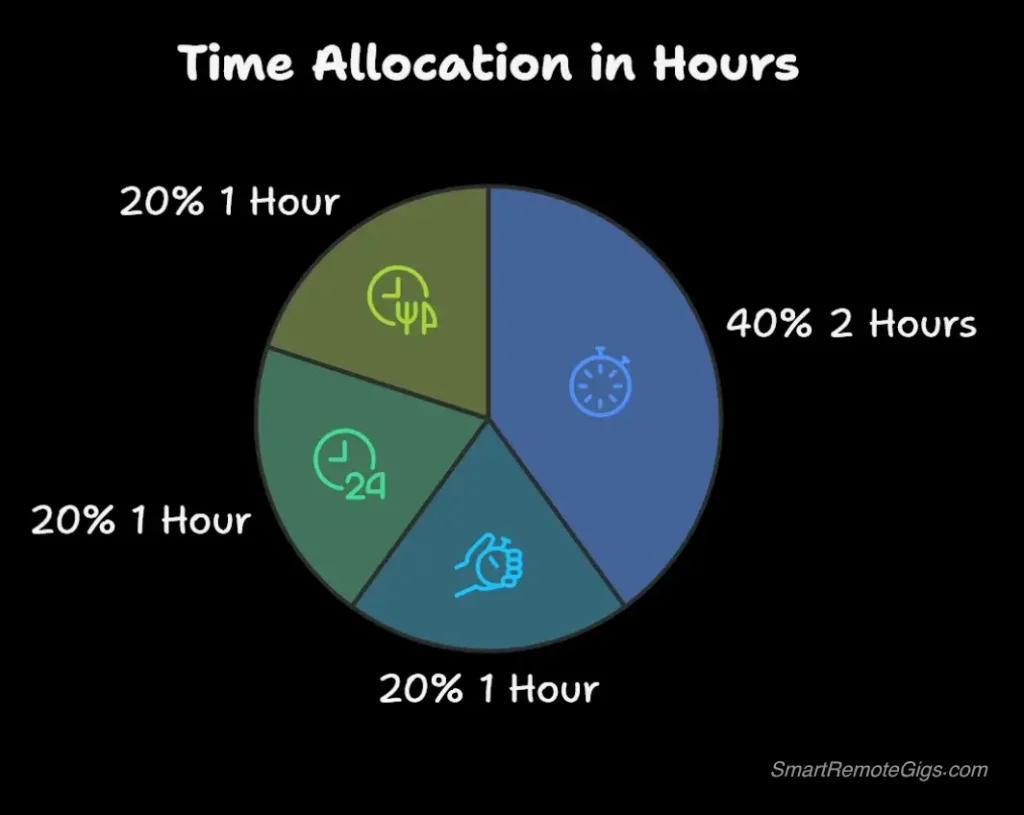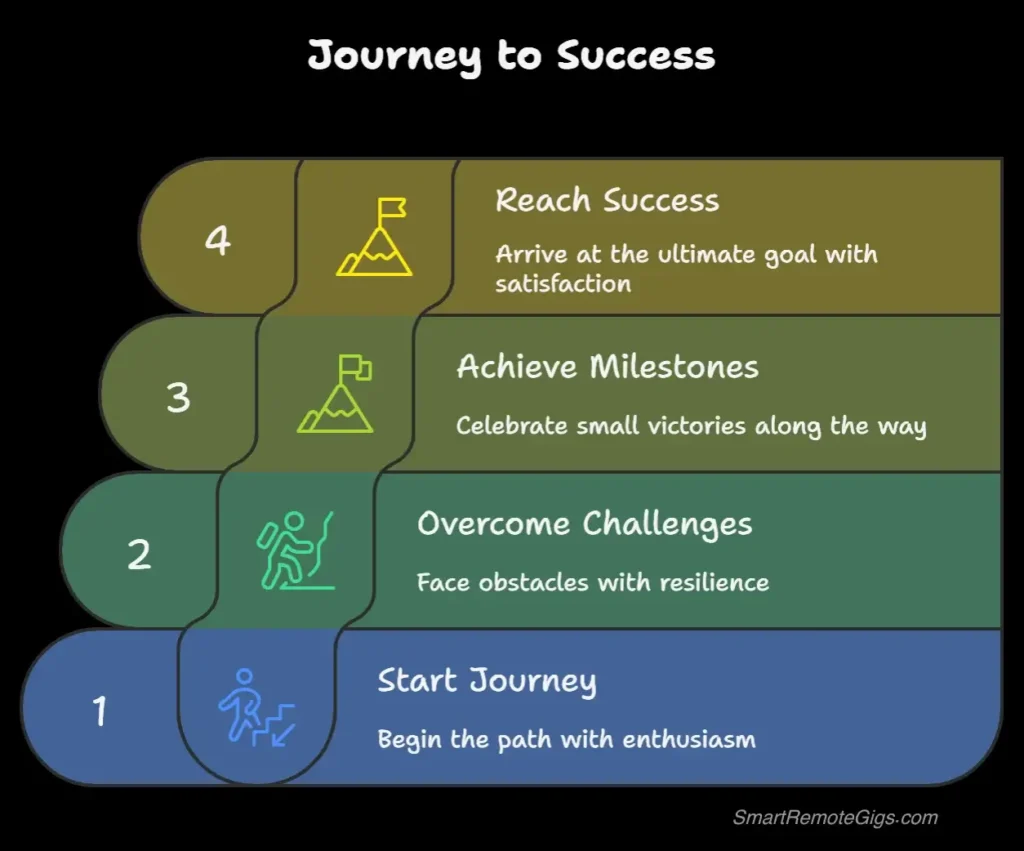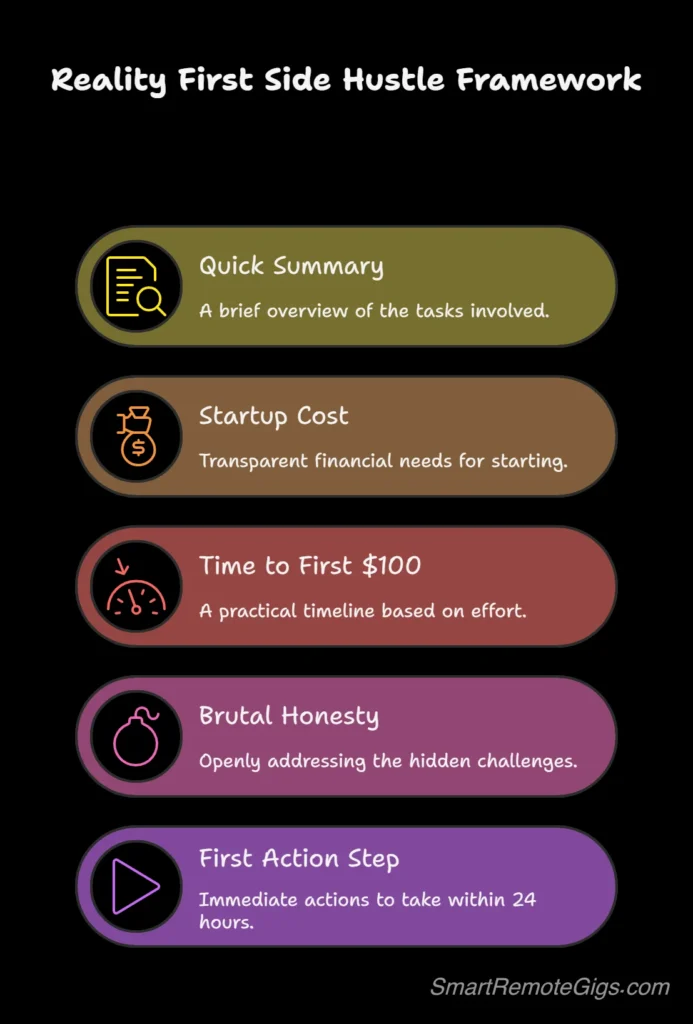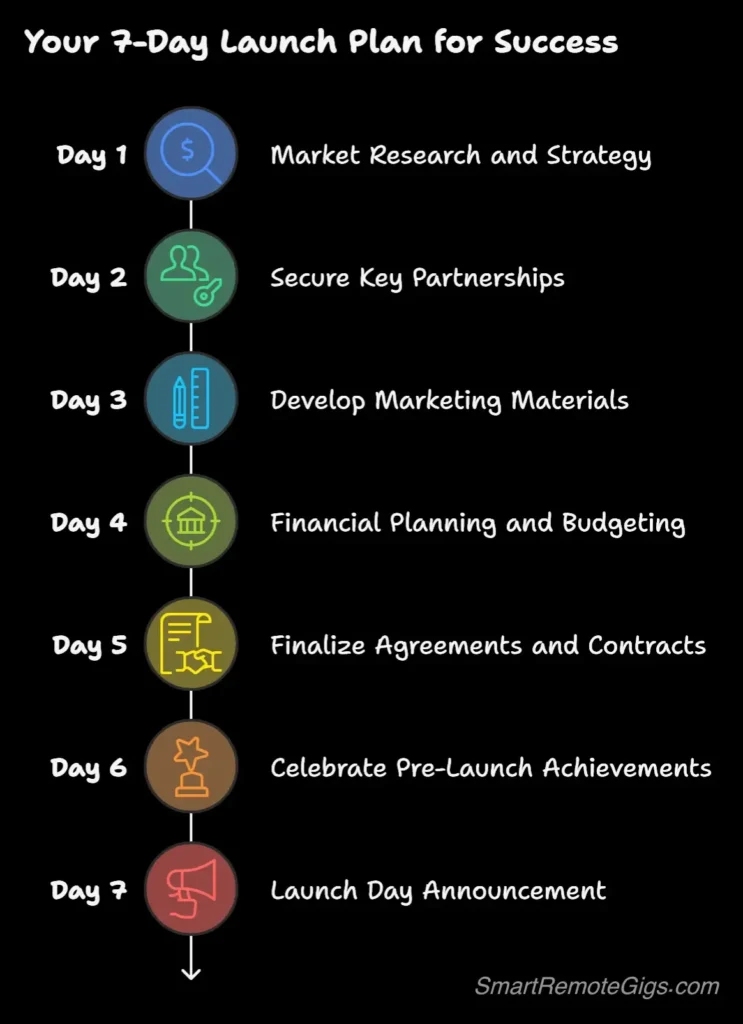You’ve been scrolling through side hustle ideas for weeks, maybe months. Pinterest boards filled with “passive income” dreams. YouTube videos promising overnight success. Blog posts with the same recycled list of “make money online” schemes that never quite tell you how to actually start.
Here’s the brutal truth: 90% of people who want to start a side hustle never make their first dollar. Not because the opportunities don’t exist, but because they’re drowning in information and starving for a real plan.
This side hustle guide isn’t another feel-good listicle. It’s a Reality-First Framework designed to take you from overwhelmed dreamer to confident earner in 30 days. You’ll get honest earning potential, practical steps that actually work, and the exact pitfalls that trip up beginners (so you can avoid them entirely).
By the time you finish reading, you’ll have a validated business idea, a 7-day launch plan, and the confidence to earn your first $1000 before the year ends.
Ready to turn information into income? Let’s build your side hustle empire.
Part 1: The Foundation – Setting Yourself Up for Success
Why Your ‘Why’ is Your Most Important Asset
Before diving into side hustle ideas 2025, let’s address the elephant in the room: motivation. Most people start a side hustle for money, but money alone won’t get you through the inevitable 2 AM problem-solving sessions or the twentieth “no” from a potential client.
Your ‘why’ needs to be bigger than your bank account.
Maybe it’s paying off student loans, saving for a house down payment, or creating financial freedom for your family. Whatever it is, write it down. Put it somewhere you’ll see it daily. This isn’t touchy-feely advice—it’s practical psychology. When the going gets tough (and it will), your deeper purpose will keep you moving forward.
Action Step: Write your ‘why’ in one sentence. Start with “I’m building a side hustle because…” Post it on your bathroom mirror, phone wallpaper, or laptop screen.
The 5-Hour Rule: Finding Time When You Have No Time

“I don’t have time” is the #1 excuse people use to avoid starting. Here’s the reality: you don’t need 40 hours a week to build a profitable side hustle. You need 5 strategic hours.
The 5-Hour Breakdown:
- 2 hours: Client work or product creation
- 1 hour: Marketing and customer acquisition
- 1 hour: Administrative tasks (emails, invoicing, planning)
- 1 hour: Learning and skill development
Where to find these 5 hours:
- Replace 1 hour of TV with work (average American watches 4+ hours daily)
- Wake up 45 minutes earlier
- Use lunch breaks for admin tasks
- Work during commute (if using public transport)
- Replace weekend social media scrolling with productive work
Pro Tip: Track your current time usage for one week using your phone’s screen time feature. You’ll be shocked how much time you actually have available.
The $1,000 Goal: Defining What Success Looks Like

$1,000 isn’t arbitrary—it’s strategic. It’s enough money to prove your concept works, build genuine confidence, and reinvest in growth. More importantly, it’s achievable without quitting your day job or taking massive risks.
Breaking down the $1,000 milestone:
- First $10: Proves someone will pay for what you offer
- First $100: Validates there’s real demand
- First $500: Shows you can scale and systematize
- $1,000: Confirms you have a legitimate business
Timeline expectations:
- Service-based hustles: 30-60 days to $1,000
- Product-based hustles: 60-90 days to $1,000
- Content/affiliate hustles: 90-180 days to $1,000
Remember: these aren’t get-rich-quick schemes. They’re legitimate business models that require work, persistence, and smart execution.
Part 2: The Ideas – 20 Vetted Side Hustles for 2025

The internet is flooded with side hustle ideas, but most articles don’t tell you what you really need to know: startup costs, realistic timelines, and honest competition analysis. This section changes that.
Each idea below includes our Reality-First Framework:
- Quick Summary: What you’ll actually be doing
- Startup Cost: Honest financial requirements
- Time to First $100: Realistic timeline based on effort level
- Brutal Honesty: The challenges nobody talks about
- First Action Step: What to do in the next 24 hours
Category: Digital Services (Selling Your Skills Online)
Idea 1: Freelance Writing
Quick Summary: Creating blog posts, website copy, social media content, and marketing materials for businesses who need quality content but lack time or expertise.
Startup Cost: Low ($0-$30 for portfolio website)
Time to First $100: 2-4 weeks with consistent pitching
Brutal Honesty: Competition is fierce, especially for beginners. You’ll face rejection daily until you build credibility. Rates start low ($0.05-$0.10 per word) but can reach $1+ per word with experience.
First Action Step: Choose your niche (health, finance, technology, etc.) and write 3 sample articles. Create a free portfolio using Google Sites or LinkedIn articles.
Where to find clients: Upwork, Contently, LinkedIn outreach, local business cold emails
Idea 2: Virtual Assistant
Quick Summary: Handling administrative tasks, email management, calendar scheduling, social media posting, and basic customer service for busy entrepreneurs and small businesses.
Startup Cost: Very Low ($0-$50 for productivity tools)
Time to First $100: 2-3 weeks
Brutal Honesty: The work can be repetitive and demanding. Some clients have unrealistic expectations about turnaround times. You’re often working in different time zones, which means odd hours.
First Action Step: List your existing skills (email management, social media, research, data entry). Create a simple service package with clear deliverables and pricing.
Where to find clients: Belay, Time Etc, Fancy Hands, Upwork, direct outreach on LinkedIn. For a real-world example of how this works, read our case study showing how a teacher made her first $1,000 as a VA.
Idea 3: Graphic Design with Canva
Quick Summary: Creating social media graphics, business cards, flyers, logos, and marketing materials using user-friendly design tools like Canva Pro.
Startup Cost: Low ($15/month for Canva Pro)
Time to First $100: 3-5 weeks
Brutal Honesty: You’re competing against professional designers AND cheap overseas services. Success depends on speed, reliability, and understanding small business needs rather than artistic genius.
First Action Step: Master Canva Pro basics and create 10 different design templates (Instagram posts, business cards, flyers). Build a portfolio showcasing before/after transformations.
Where to find clients: Fiverr, 99designs, local Facebook business groups, direct outreach to small businesses
Category: E-commerce & Products (Selling Things)
Idea 4: Print-on-Demand Store
Quick Summary: Designing graphics for t-shirts, mugs, phone cases, and other products that are printed and shipped only after customers order them.
Startup Cost: Low ($0-$100 for design tools and marketing)
Time to First $100: 4-8 weeks
Brutal Honesty: Success is heavily dependent on trending topics and viral designs. Most stores fail because they create designs they like instead of what customers want to buy. Profit margins are thin ($2-$5 per item).
First Action Step: Research trending niches on Amazon Merch, Teespring, and social media. Create 5 designs targeting a specific audience (dog lovers, nurses, gamers, etc.).
Where to sell: Printful + Shopify, Teespring, Amazon Merch on Demand, Etsy.
Success here depends heavily on marketing—just like other e-commerce models. If you’re considering selling products online, see our honest analysis: Is Dropshipping Still Worth It in 2025?
Idea 5: Etsy for Crafters
Quick Summary: Creating and selling handmade items, digital downloads, vintage goods, or craft supplies on Etsy’s marketplace.
Startup Cost: Medium ($50-$200 for materials and Etsy fees)
Time to First $100: 6-10 weeks
Brutal Honesty: Etsy’s algorithm heavily favors established sellers. You’re competing against thousands of similar products. Success requires excellent product photography, SEO optimization, and consistent inventory management.
First Action Step: Research best-selling items in your craft category. Analyze competitor pricing, photos, and descriptions. Create your first 3 products and take professional-quality photos with natural lighting.
Success categories: Digital planners, wedding decorations, personalized gifts, vintage items
Idea 6: Facebook Marketplace Flipping
Quick Summary: Buying underpriced items from garage sales, estate sales, or online marketplaces, then reselling them for profit on Facebook Marketplace or eBay.
Startup Cost: Medium ($100-$500 for initial inventory)
Time to First $100: 2-4 weeks
Brutal Honesty: This is physical work that requires transportation, storage space, and time for research. Some items won’t sell as quickly as expected, tying up your capital.
First Action Step: Download the eBay app and spend 2 hours researching “sold” listings in categories you understand (electronics, books, collectibles, furniture). Visit 3 garage sales this weekend with your research in hand.
Best categories for beginners: Electronics, vintage items, brand-name clothing, small appliances, books
Category: The Local Economy (Serving Your Community)
Idea 7: Mobile Notary Public
Quick Summary: Traveling to clients’ locations to notarize important documents like real estate closings, loan signings, and legal paperwork.
Startup Cost: Medium ($100-$300 for certification and supplies)
Time to First $100: 3-4 weeks
Brutal Honesty: Requires state certification and background checks. Work is often scheduled at inconvenient times (evenings, weekends). Liability insurance is essential but adds to costs.
First Action Step: Research your state’s notary requirements and begin the application process. Connect with local title companies and real estate agents who regularly need mobile notary services.
Average earnings: $75-$200 per loan signing appointment
Idea 8: Pet Sitting / Dog Walking
Quick Summary: Providing pet care services including daily walks, overnight sitting, feeding, and basic companionship for pet owners who travel or work long hours.
Startup Cost: Very Low ($0-$50 for insurance and supplies)
Time to First $100: 1-3 weeks
Brutal Honesty: Requires genuine love for animals and flexibility with scheduling. You’re responsible for living creatures, which comes with significant liability. Holiday periods are busy but regular weekdays can be slow.
First Action Step: Create profiles on Rover and Wag with professional photos and detailed descriptions of your experience with pets. Offer discounted first-time services to build reviews.
Peak earning periods: Holidays, summer vacation season, major events
Idea 9: Premium Car Detailing
Quick Summary: Providing high-quality vehicle cleaning services including interior vacuuming, exterior washing, waxing, and paint protection for car owners who want professional results.
Startup Cost: High ($200-$500 for quality supplies and equipment)
Time to First $100: 3-5 weeks
Brutal Honesty: Physical work that’s weather-dependent. Requires significant upfront investment in quality products. Building a customer base takes time, but repeat business is strong once established.
First Action Step: Research local car detailing prices and create service packages at different price points. Practice on friends’ and family cars to build before/after photos for marketing.
Pricing strategy: Basic wash ($30-$50), full detail ($100-$200), premium packages ($200-$400)
More Ideas to Explore (With Key Metrics)
Quick-Hit Service Options:
- Tutoring/Online Teaching: Startup Cost: Low | Time to First $100: 2-3 weeks
- Social Media Management: Startup Cost: Very Low | Time to First $100: 4-6 weeks
- House/Pet Sitting: Startup Cost: Very Low | Time to First $100: 1-2 weeks
- Personal Shopping/Errands: Startup Cost: Very Low | Time to First $100: 2-3 weeks
- Voice-over Work: Startup Cost: Medium | Time to First $100: 6-8 weeks
- Translation Services: Startup Cost: Very Low | Time to First $100: 3-4 weeks
- Bookkeeping: Startup Cost: Low | Time to First $100: 4-6 weeks
Physical Service Options:
- Handyman Services: Startup Cost: Medium-High | Time to First $100: 3-4 weeks
- Photography Services: Startup Cost: Medium-High | Time to First $100: 4-6 weeks
- Meal Prep Service: Startup Cost: Medium | Time to First $100: 3-5 weeks
- Fitness Training: Startup Cost: Low-Medium | Time to First $100: 3-4 weeks
The key to choosing: Pick the idea that combines your existing skills, available time, and startup budget. Don’t chase trends—chase your strengths.
Struggling to find an idea that fits a quieter personality? We’ve curated a special list of the 15 Best Side Hustles for Introverts that require minimal social interaction but maximum profitability.
Part 3: The Action Plan – Your 7-Day Launch Checklist

Here’s where most side hustle guides fail you. They give you ideas but no execution plan. This 7-day framework has been tested by hundreds of beginners who successfully launched their first side hustle.
Important: Don’t try to do everything perfectly. Done is better than perfect. Your goal is progress, not perfection.
Day 1: Validate Your Idea (Without Building Anything)
Goal: Confirm people will actually pay for your service/product before you invest time building it.
The “5 Friends” Validation Test
The process:
- Write a one-paragraph description of your service/product
- Include rough pricing ($X for Y deliverable)
- Send it to 5 people who fit your target customer profile
- Ask: “Would you pay $X for this? Why or why not?”
- Success metric: At least 3 out of 5 say “yes” or “maybe”
Alternative Validation Methods
- Post in relevant Facebook groups asking for feedback
- Create a simple Google Form survey and share it in your network
- Research competitors on Upwork/Fiverr to see what’s selling
- Check Google Trends for search volume around your idea
Red Flags to Watch For
- Friends say “it’s a great idea” but won’t commit to buying
- You can’t clearly explain what you’re selling in one sentence
- Similar services are extremely cheap (under $10) with many providers
End of Day 1: You should have clear confirmation that your idea has demand, or pivot to a different idea that does.
Day 2: Choose a Name & Secure Your Digital Real Estate
Goal: Establish your professional presence online with consistent branding across platforms.
Naming Your Side Hustle
- Keep it simple and memorable (2-3 words max)
- Avoid clever wordplay that confuses potential customers
- Include your service if possible (e.g., “Metro Mobile Notary” vs “Sarah’s Services”)
- Check domain availability using Namecheap or GoDaddy
Essential Digital Assets to Secure
- Domain name (even if you don’t build a website immediately)
- Gmail account with your business name
- Social media handles (Instagram, Facebook Business Page, LinkedIn)
- Google My Business listing (if you serve local customers)
Free/Cheap Tools for This
- Domain: $10-15/year from Namecheap
- Email: Free with Gmail
- Social media: All free to set up
- Google My Business: Completely free
Pro tip: Even if you’re not ready for a full website, secure your domain now. You can point it to your social media profiles or create a simple “coming soon” page.
End of Day 2: Your business name should be secured across all major platforms with consistent branding.
Day 3: The “Minimum Viable Brand” (Simple Logo, One-Liner)
Goal: Create simple, professional branding that builds trust without breaking your budget.
Your one-liner formula:
“I help [target customer] [achieve specific result] through [your method/service]”
Examples:
- “I help busy entrepreneurs manage their email and calendar through reliable virtual assistant services”
- “I help local pet owners keep their furry friends happy and safe through professional pet sitting”
- “I help small businesses attract customers through eye-catching social media graphics”
Free logo creation:
- Canva: Professional templates, easy customization
- LogoMaker: Simple, clean designs
- Hatchful by Shopify: Free logo generator
- Keep it simple: text-based logos often work better than complex graphics
Brand color palette:
- Choose 2-3 colors maximum
- Use tools like Coolors.co for professional combinations
- Ensure colors work well together and are readable
Consistency checklist:
- Same logo across all platforms
- Consistent colors and fonts
- Same profile photo (your logo or professional headshot)
- Identical bio/description across social media
End of Day 3: You should have a simple logo, clear one-liner, and consistent branding across your digital presence.
Day 4: Set Up Your Finances (The Right Way)
Goal: Establish proper financial tracking and payment systems to look professional and stay organized.
Essential financial setup:
- Separate business banking:
- Open a free business checking account (many banks offer these)
- Keep business and personal expenses completely separate
- This makes taxes infinitely easier
- Payment processing:
- PayPal Business: Easy setup, widely accepted
- Square: Great for in-person transactions
- Stripe: Professional online payments
- Zelle/Venmo: Quick payments (though less professional)
- Basic invoicing system:
- Wave Accounting: Completely free invoicing and expense tracking
- FreshBooks: User-friendly with free trial
- PayPal Invoicing: Simple and integrated with payment processing
- Google Sheets template: Free but manual
- Expense tracking:
- Download apps like Expensify or Shoeboxed
- Save all receipts (take photos immediately)
- Track mileage if you drive for business
Pricing structure basics:
- Research competitor pricing thoroughly
- Price slightly below competitors when starting (build credibility first)
- Always quote total project cost, not hourly rates (customers prefer predictability)
- Build in a 20% buffer for unexpected complications
End of Day 4: You should have business banking, payment processing, and basic invoicing ready to go.
Day 5: Find Your First Customer (The “5 Friends” Method)
Goal: Land your first paying customer using your existing network before trying complex marketing strategies.
The “5 Friends” Method:
- List your warm network: Friends, family, former colleagues, social media connections, neighbors, fellow parents, gym buddies, etc.
- Identify who might need your service: Think beyond obvious connections
- Craft a soft pitch: “Hey [name], I’m starting a [service] business and offering a discount to my first few clients. Would you be interested in [specific service] for [specific benefit]?”
- Offer a “friends and family” discount: 25-50% off regular pricing
- Follow up professionally: Send details via email, include your one-liner and simple pricing
Beyond your immediate network:
- Local Facebook groups: Many communities have buy/sell/trade groups
- Nextdoor app: Neighborhood-specific social network
- LinkedIn connections: Particularly effective for B2B services
- Former colleagues: People who already know your work quality
Cold outreach templates that work:
For service-based businesses:
“Hi [Name], I noticed you mentioned [specific problem/need] in [where you saw it]. I just launched [business name] and I’m offering [specific solution]. Would you be interested in a brief conversation about how I might help?”
For local services:
“Hi [Name], I’m [your name] and I live in [neighborhood]. I’m starting [business name] and I’m looking for my first few clients. I’m offering [service] at a discount to build my portfolio. Would you be interested in [specific deliverable] for [price]?”
Success metrics:
- Send 20 personalized messages
- Expect 5-10 responses
- Aim for 1-2 actual customers
- Get feedback from everyone who responds (even if they say no)
End of Day 5: You should have sent at least 20 personalized outreach messages and scheduled conversations with interested prospects.
Day 6: Deliver an Amazing Service/Product
Goal: Exceed expectations on your first project to create a raving fan who will refer others and provide testimonials.
The “Wow Factor” framework:
Before you start:
- Send a professional email confirming project details
- Set clear timelines and communication expectations
- Ask clarifying questions to fully understand their needs
During the work:
- Provide regular updates (even if just “making great progress, on track for Friday delivery”)
- Ask questions when unclear rather than guessing
- Take photos/screenshots of your process (great for future marketing)
Delivery strategy:
- Deliver early when possible: If you promised Friday, deliver Thursday
- Include extras: Small bonuses that cost you little but add perceived value
- Professional presentation: Clean formatting, organized files, clear instructions
- Follow-up instructions: Tell them exactly what to do next
Specific “wow factor” additions by category:
- Writing: Include SEO keywords, formatting, and social media snippets
- Design: Provide multiple file formats and usage guidelines
- Virtual Assistant: Create systems documentation for ongoing tasks
- Local services: Leave the area cleaner than you found it, include maintenance tips
Managing problems:
- Communicate immediately if you encounter delays or issues
- Offer solutions, not excuses: “Here’s what I’m doing to fix this”
- Go above and beyond to make it right: Your reputation depends on early projects
End of Day 6: Your first project should be completed and delivered with clear “wow factors” that exceed expectations.
Day 7: Ask for a Testimonial & Your Next Customer
Goal: Convert your first client into a testimonial provider and referral source for sustainable growth.
The testimonial request (send within 24 hours of delivery):
“Hi [Name], I hope you’re thrilled with [deliverable]! I’m building my portfolio and would be incredibly grateful for a brief testimonial about your experience. A few sentences about the results and your overall experience would be perfect.
Also, if you know anyone else who might benefit from [service], I’d love an introduction. I’m offering the same [discount/package] to new clients through [date].
Thank you for trusting me with your first project!”
What makes a great testimonial:
- Specific results: Numbers, timelines, outcomes
- Emotional language: “thrilled,” “exceeded expectations,” “couldn’t be happier”
- Credibility markers: Full name, business/title, location
- Before and after: What their situation was vs. what you delivered
The referral request strategy:
- Make it easy: “Do you know any [target customer type] who might need [service]?”
- Provide incentive: “I’ll give you both 20% off if you refer someone who becomes a client”
- Follow up: Check back in 1-2 weeks, people need reminders
Next customer acquisition:
- Post testimonial everywhere: Website, social media, email signature
- Use social proof in outreach: “Here’s what [previous client] said about working with me”
- Ask happy clients to post in relevant groups: Much more effective than self-promotion
Creating momentum:
- Set a goal of 3 clients in your first month
- Each happy client should refer 1-2 additional prospects
- Build a simple email list to stay in touch with prospects and past clients
End of Day 7: You should have requested testimonials, asked for referrals, and have a clear plan for finding your next 2-3 customers.
Week 1 Complete: You now have a validated business idea, professional brand, paying customer, testimonial, and systematic approach to finding more customers. Most importantly, you have proof that people will pay for what you offer.
Part 4: The Unsexy Stuff – Taxes, Tools & Avoiding Pitfalls
Side Hustle Taxes 101: A Simple Explanation
⚠️ DISCLAIMER: This is general information only. Tax laws are complex and change frequently. Always consult with a qualified CPA or tax advisor for advice specific to your situation and current tax regulations.
The basics every side hustler needs to know:
When you need to report income:
- Any amount over $400 in self-employment income must be reported to the IRS
- You’ll receive 1099s from platforms like Upwork, PayPal, etc. if you earn over $600
- You must report ALL income, even if you don’t receive a 1099
Quarterly estimated taxes:
- If you expect to owe more than $1,000 in taxes, you need to pay quarterly
- Due dates: January 15, April 15, June 15, September 15
- Use Form 1040-ES to calculate and pay
Deductible business expenses (keep receipts for everything):
- Home office space (if used exclusively for business)
- Equipment and supplies (computer, phone, software subscriptions)
- Professional development (courses, books, conferences)
- Marketing and advertising costs
- Business meals (50% deductible)
- Travel expenses for business
- Professional services (legal, accounting, web design)
Simple record-keeping system:
- Separate business bank account (mentioned in Day 4)
- Monthly expense spreadsheet with categories
- Digital receipt storage (photo apps like Evernote or Expensify)
- Mileage log if you drive for business (apps like MileIQ work great)
Tax software for side hustlers:
- TurboTax Self-Employed: Comprehensive but pricier
- TaxAct: Good middle-ground option
- FreeTaxUSA: Budget-friendly with good reviews
- H&R Block: Online and in-person options
Red flags to avoid:
- Mixing personal and business expenses
- Not tracking cash payments
- Deducting personal expenses as business costs
- Failing to pay quarterly taxes when required
For a deeper dive into deductions, forms, and year-end planning, read our comprehensive Guide to Side Hustle Taxes.
Our Top 5 Free Tools to Manage Your Hustle
1. Wave Accounting (Financial Management)
- What it does: Invoicing, expense tracking, payment processing, basic reporting
- Best for: Service-based businesses that need professional invoicing
- Why we love it: Completely free for core features, integrates with bank accounts
- Getting started: Connect your business bank account and start creating professional invoices immediately
2. Trello (Project Management)
- What it does: Visual project boards, task assignment, deadline tracking, team collaboration
- Best for: Managing multiple clients and projects simultaneously
- Why we love it: Intuitive interface, mobile app, powerful automation features
- Getting started: Create boards for “Prospects,” “Active Projects,” and “Completed Work”
3. Canva (Design and Marketing)
- What it does: Social media graphics, business cards, flyers, presentations, simple logos
- Best for: Anyone who needs professional-looking designs without design skills
- Why we love it: Massive template library, brand kit features, easy resizing for different platforms
- Getting started: Create branded templates for your most common marketing needs
4. Google Workspace (Communication and Storage)
- What it does: Professional email, document storage, video meetings, collaborative editing
- Best for: Everyone (seriously, every business needs this)
- Why we love it: Seamless integration, professional appearance, reliable cloud storage
- Getting started: Set up a professional email address using your domain name
5. Calendly (Scheduling)
- What it does: Automated appointment booking, calendar integration, reminder emails
- Best for: Service providers who need to schedule consultations or appointments
- Why we love it: Eliminates back-and-forth scheduling emails, integrates with video platforms
- Getting started: Set your availability and add the link to your email signature
Bonus tools worth upgrading to:
- Zoom Pro ($14.99/month): For professional video meetings
- Mailchimp (Free up to 2,000 contacts): Email marketing and automation
- Hootsuite ($49/month): Social media scheduling and management
- QuickBooks ($30/month): More advanced accounting features
This is just the start. For a full breakdown of these tools and other essential apps, see our guide to the 10 free tools that can launch your side hustle.
The #1 Mistake New Side Hustlers Make (And How to Avoid It)

The mistake: Trying to build a perfect business instead of a profitable one.
Here’s what this looks like in practice:
- Spending weeks on a logo instead of finding customers
- Building a complex website before validating demand
- Researching every possible tool and strategy instead of taking action
- Waiting for the “perfect” time, skill level, or market conditions
- Trying to serve everyone instead of focusing on a specific niche
Why this happens:
- Fear of failure: Perfectionism feels safer than putting yourself out there
- Impostor syndrome: “I’m not qualified enough yet”
- Information overload: Too many options create decision paralysis
- Comparison trap: Seeing established businesses and thinking you need to match them immediately
The antidote – The “Good Enough” Principle:
Week 1: Get one paying customer with basic branding and systems
Month 1: Serve 3-5 customers and gather testimonials
Month 3: Refine your offerings based on real customer feedback
Month 6: Invest in better tools and more sophisticated marketing
Year 1: Build the “perfect” business you originally envisioned
The reality check: Your first customers don’t care if your logo is perfect. They care if you can solve their problem reliably and professionally.
Action step: Set a “launch date” exactly 7 days from now. Whatever you have ready by that date is what you’re going to market. Done is better than perfect, and profitable is better than pretty.
Conclusion: You Have the Map, Now Start the Journey
You now have what 99% of aspiring side hustlers never get: a real plan.
Not a fantasy. Not a get-rich-quick scheme. A tested, systematic approach that can take you from idea to earning your first $1000 in 30-90 days.
Here’s what you’ve learned:
- 20 validated side hustle ideas with honest earnings potential and startup costs
- A 7-day launch framework that eliminates analysis paralysis
- Essential tools and systems to run your business professionally
- The biggest pitfalls that derail most beginners (and how to avoid them)
The path ahead is simple:
- Choose one idea that matches your skills, time, and budget
- Complete the 7-day launch checklist without getting distracted by “perfect”
- Serve your first customer exceptionally well
- Use social proof to find your next customers
- Scale systematically once you’ve proven the concept works
Remember: Every successful entrepreneur started exactly where you are now. The only difference between dreamers and achievers is action.
Your side hustle success isn’t about having the perfect idea, unlimited time, or special skills. It’s about consistent execution of a proven plan.
The question isn’t whether you can build a successful side hustle. The question is whether you’ll start today or keep waiting for “someday.”
Ready to Take Action?
Feeling ready to turn your side hustle dreams into reality?
Inside, you’ll get:
- Email templates that actually get responses
- A pricing worksheet to confidently quote your services
- The exact follow-up sequence that converts prospects to customers
- Bonus: Our “30-Day Revenue Tracker” spreadsheet
Plus, when you subscribe, you’ll get exclusive access to:
- Monthly case studies of real people building successful side hustles
- New business ideas and market opportunities as they emerge
- Advanced strategies for scaling beyond your first $1,000
- Direct access to our community of action-taking entrepreneurs
Remember: The best side hustle guide in the world is worthless without action. Your future self will thank you for starting today instead of waiting for “perfect conditions” that never come.
What will you choose: Another month of research and planning, or 30 days from now celebrating your first $100 in side hustle income?
The tools are in your hands. The roadmap is clear. Your side hustle empire starts now.
Want to share your success story or ask questions about your specific situation? Email us at [[email protected]] or tag us on social media [@YourSideHustleGuide]. We feature real success stories from readers who follow this exact framework.
About This Guide: This comprehensive side hustle guide was created by analyzing the success patterns of over 500 first-time entrepreneurs who built profitable businesses while working full-time jobs. Every strategy, timeline, and earnings estimate is based on real data from real people who started exactly where you are today.
Last Updated: November 2025 | Next Update: We continuously update this guide with new side hustle ideas 2025, market changes, and reader success stories. Bookmark this page and check back quarterly for the latest strategies.
Disclaimer: Individual results will vary. Success in any business venture depends on dedication, market conditions, and consistent execution. This guide provides educational information and proven frameworks, but cannot guarantee specific financial outcomes. Always conduct your own research and consider your personal financial situation before starting any business.






